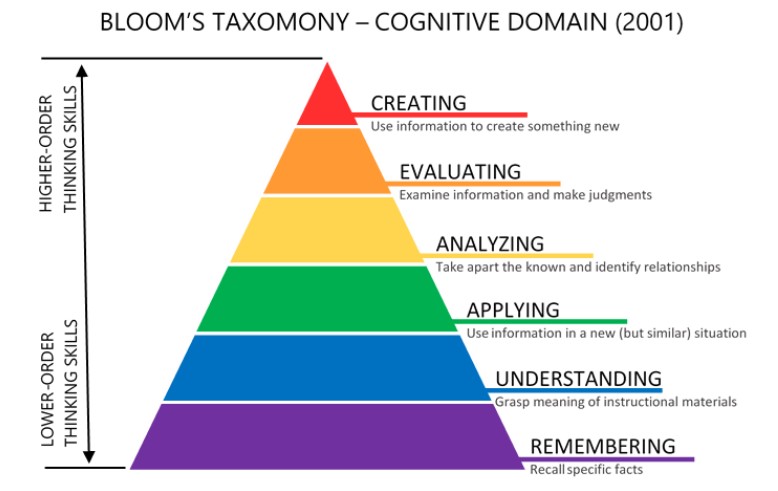Rapid technological change will transform the classroom for the next generation of learners. As a result, the advent of pedagogical innovation that puts learners at the center of learning is a constant trend in the coming years. In addition, the never-ending quest for knowledge will require new assessment mechanisms to rise in learning institutions. Nonetheless, learning begins in the classroom. Therefore, the academe must identify achievable learning goals and develop plans to meet them using a foundational framework that can be effectively applied in the learning process to benefit both educators and learners.
One of the most recognized theories in education is Bloom’s Taxonomy, which has become a standard for developing learning objectives, assessments, and activities. Educators have long used this framework to help plan lessons and design curricula. This model encourages learners to develop higher-order thinking levels of cognitive skills. The hierarchy used in this taxonomy aids teachers in designing assessments, preparing discussions with learners, and providing students feedback on every submission.
What is Bloom’s Taxonomy?
Formerly known as the Taxonomy of Educational Objectives, Bloom’s Taxonomy was developed by Benjamin Bloom, an American professor at the University of Chicago. In 1956, this framework comprised learning objectives and activities that engage learners in higher-level thinking. The framework consists of three (3) learning domains that correspond to distinct levels of learning, such as cognitive, affective, and psychomotor. Using the cognitive domain as an example, before a learner can conduct an analysis, the student would need to know the analysis methods, understand the different elements to review and consider which method to apply. Only then would the student be ready to execute the analysis.
There were six (6) main categories from simplest to complex: Knowledge, Comprehension, Application, Analysis, Synthesis, and Evaluation – where knowledge was the foundation for learning. Correspondingly, the rest of the skills and abilities that followed depended on how the knowledge was acquired. A few years after, David Krathwhol, an American educational psychologist, met with other experts to review and update the taxonomy of the original Bloom project. As a result, in 2001, the categories changed from nouns to verbs in the revised taxonomy, reflecting teacher and student actions. Also, reorganizing the categories in this manner: Remember, Understand, Apply, Analyse, Evaluate, and Create.

The Hierarchical Pyramid
The cognitive component of Bloom’s Taxonomy is represented by a hierarchical pyramid that sorts cognitive skills that are conducive to various stages of learning. The pyramid shows the increase in the difficulty of assessment as students move up to the next level. Educators can use this order to develop tasks based on the learning goals for a particular course. For example, a learner who starts with a simple assessment eventually progresses to a more complex activity over a period.

Essentially, Bloom’s Taxonomy combines knowledge and application, allowing valuable personalized learning paths to advance. This model moves away from the one-size-fits-all teaching tradition, which leaves some students behind. More so, since learners develop differently, applying Bloom’s taxonomy to the design of learning programs and proficiency measurements can contribute to an increased learning efficacy of students.
How do Bloom’s Taxonomy benefit learners and teachers?
The bottom line in teaching is for students to learn, not just merely pass an assessment. As they develop higher-order thinking skills, they are more likely to develop skills needed to thrive in every life stage. Hence, a good mix of lower and higher-level learning engagements allows learners to have substantial exposure to both content and skills. In addition, as they go through the process, students are provided with tools that will foster critical thinking skills, going beyond memorizing concepts.
Arguably, Bloom’s Taxonomy offers a better class exchange between learners and teachers. Further, clear and organized learning goals benefit teachers because they can make appropriate activities, design appropriate instructional strategies, and review the consistency of the instruction and evaluation of the learning objectives.
Complimentary to helping develop learning expectations, Bloom’s Taxonomy can help develop instructional strategies. Teachers can refer to the learning objectives in the process, enabling them to create activities that foster better learning. Higher-order thinking skills go beyond the basic study of facts and memorization. These can be activated when learners encounter unfamiliar situations, uncertainties, questions, or difficulties. Applying these skills early in the classroom allows most learners to develop their creative tendencies and divergent thinking skills that will help them adapt to a dynamic future.
References:
Anderson, L. W., & Krathwohl, D. R. (Eds.). (2001). A taxonomy for learning, teaching and
assessing: A revision of Bloom’s Taxonomy of educational objectives: Complete edition. New York, Longman.
Bloom, B. S. & Krathwohl, D. R. (Eds.) (1956). Taxonomy of educational objectives: The
classification of educational goals, by a committee of college and university examiners. Handbook 1: Cognitive domain. New York, Longman.
Bloom’s taxonomy. (2021, November 10). Centre for Teaching Excellence. https://uwaterloo.ca/centre-for-teaching excellence/teachingresources/teachingtips/planning-courses-and-assignments/blooms-taxonomy
Bloom’s taxonomy. (2020, December 15). Educational Technology. https://educationaltechnology.net/blooms-taxonomy/
Moving up bloom’s taxonomy. (n.d.). Creative Educator. https://creativeeducator.tech4learning.com/v02/articles/The_New_Blooms
Munzenmaier, C., & Rubin, PhD, N. (2013). Bloom’s Taxonomy: What’s Old Is New Again. Online Teacher Education. https://onlineteachered.mit.edu/edc-pakistan/files/best-practices/session-2/Pre-Session-Munzenmaier-Rubin-2013.pdf
About Cloud Nine College (CNC)
Cloud Nine College is a premier vocational (Co-Op) college offering a range of specialized co-op courses and comprehensive Intensive English Programs, including test preparation courses for IELTS and general and business ESL courses to international students. It coordinates its programs uniquely in such ways that students can advance their education to the next level at universities and job opportunities.
CNC is also an online education platform offering online certificate, diploma, higher diploma, and postgraduate diploma programs progressing to online and offline undergraduate and postgraduate degrees awarded by various educational institutions and universities around the world
Cloud Nine College started as a language training institution back in 2010 and now has expanded into providing career training programs:
- Hotel and Restaurant Management Co-op Diploma
- Hotel and Restaurant Management Co-op Certificate
- International Trade and Business Management Co-op Diploma
- Professional Sales Co-op Certificate
Statement of Purpose
The mission of the Cloud Nine College is to assist students in defining and acquiring a comprehensive set of career training and English language skills that meet their objectives and help create meaningful pathways to and opportunities in their personal, educational, and commercial endeavors.
Learn more about CNC at www.cloudninecollege.com/
